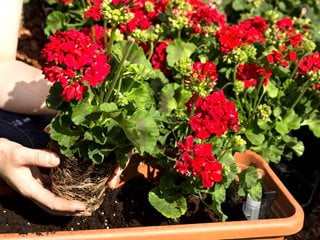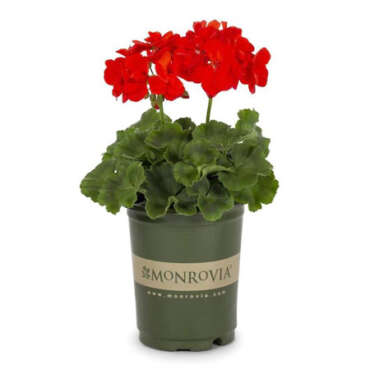Product Description
Geraniums – 4 1/2″ Pots (8)
Geraniums are easy-care abundant bloomers whose bright flowers will blossom from spring until fall. Geranium plants are grown as annuals in most zones, but are considered evergreen perennials in zones 10 and 11. Although commonly called geranium, this well-known potted plant, native to South Africa, is actually a Pelargonium.
BASICS
Zones:
Winter hardy in zones 10-11, grown as an annual or over-wintered indoors in colder zones.
Height/Spread:
Varies by type; most common varieties average 2 to 4 feet tall and wide, dwarf cultivars available in heights 5 to 8 inches, and ivy types spread 6 to 48 inches.
Exposure:
Most grow best in full sun. Regal varieties do like some partial shade and zonals will tolerate some shade. In extremely hot climates, some afternoon protection should be provided.
Bloom time:
Geraniums are appreciated for their long blooming season that starts in spring and can last into fall. If plants are kept above 45 to 50 degrees, they may also bloom in winter to early spring.
Color:
Flowers come in shades of white, red, pink, purple, mauve, orange, and reddish-black. Geranium leaves can be green, gold, chartreuse, bronze, red, multi-colored, or patterned.
Are geraniums toxic?
According to the ASPCA, geraniums are toxic to dogs and cats. Clinical signs of ingestion or exposure are vomiting, anorexia, depression, and dermatitis. It’s important to make sure plants are kept far out of your pet’s reach. See more Common Poisonous Plants for Dogs and Cats.
TYPES OF GERANIUMS
Most belong to one of six groups:
- Zonal geraniums
- Ivy geraniums
- Interspecific geraniums
- Regal or Martha Washington geraniums
- Scented-leaf geraniums
- Angel geraniums
HOW TO PLANT GERANIUMS
When to plant:
Sow seeds indoors 10 weeks before last frost. Plant seedlings outdoors in spring after all threat of frost has passed. Container-grown transplants are best planted in spring.
Where to plant:
Plant geraniums in an area that will get at least 6 hours of sun a day, in fertile, well-draining soil.
How to plant:
For potted plants, place seedlings in 4-inch containers and move up to larger pots as they grow. Plant in-ground geraniums with 6 to 24 inches between them, depending on their growth habit; don’t overcrowd them.
GERANIUM CARE

Photo by: Tibanna79 / Shutterstock.
Pruning:
Regular pruning can help keep your plant in shape. Pinch back new growth several times in late spring to early summer to encourage branching. Faded flowers should be deadheaded regularly to boost blooming and extend the flowering season.
Soil:
Geraniums prefer fertile, neutral to alkaline, well-drained soil.
Amendments & Fertilizer:
Apply a balanced liquid fertilizer monthly in spring and early summer. Over fertilizing can result in poor blooming, as it redirects the plant’s energy to foliage growth rather than flowering.
Watering:
Although they have fairly low water requirements once established, consistent watering is best. Not enough water can cause leaf drop and wilting and too much water can cause them to get spindly. Allow the soil to dry somewhat between watering, but not completely. Water moderately during growth and sparingly in winter. Both over and under watering cause stress to the plant and may cause leaves to turn red.
Propagation:
Geraniums are easily propagated from stem cuttings taken in spring, late summer, or early autumn; best when there is a lull in blooming. Cut just above a stem node; this will encourage re-growth on the existing plant. Cut the new cutting again just below a node about 4 to 6 inches below the leafy end of the stem. Strip all but the top leaves and place in warm, damp potting soil. Water thoroughly and place in a bright location but out of direct sunlight. Seeds can be sown indoors 10 weeks before last frost. Water lightly until seedlings appear and keep them in a warm location. Seedlings can be placed outside after all threat of frost has passed.
Winter:
Plants can be brought indoors for overwintering. Kevin Lee Jacobs, an award-winning food, garden and lifestyle guru who lives in New York’s Hudson Valley, recommends cutting back geraniums drastically and pruning their roots before repotting and bringing indoors. See pictures of the process on his blog: How I Prepare Geraniums for Winter. Keep them in a sunny window, but don’t let them overheat.
Diseases and Pests:
Thrips, geranium budworm, spider mites, mealybugs, caterpillars, gray mold, and mildew may affect your geraniums.
Other:
Direct contact with foliage may occasionally aggravate skin allergies.
Information from www.gardendesign.com
Specifications
- Weight: 15 lb
- >>: Colors are approximate

